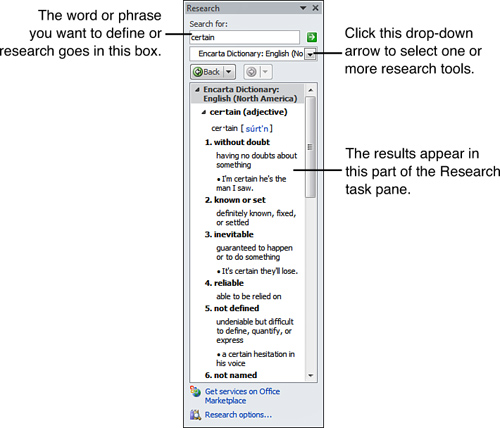There was a time when most of us kept a few
reference books on hand—a dictionary, a thesaurus, maybe even a complete
encyclopedia. But if you have Word and an Internet connection, you can
look up definitions and synonyms or even do in-depth topical research
without ever looking away from your screen. Isn’t that a thrilling
prospect?
Just as Word’s spelling checker can help you make
sure all your words are spelled correctly, Word’s research tools can
take your language to a higher level. These features can help you make
better word choices, for example, or write more accurately about your
subject. The research tools are available through the Research task
pane. (Note that you need an Internet connection for most of the
research tools to work because they find their content online.)
Finding Definitions and Synonyms
If you want to be sure you’re using a word correctly,
you need to know its meaning. Word makes it easy to look up definitions
by giving you access to Microsoft’s Encarta Dictionary. Similarly, the
Research task pane provides links to English-, French-, and
Spanish-language thesauruses (or thesauri, if you prefer), where you can
find synonyms for nearly any word.
Looking Up a Definition
Before you look up a definition, make sure the word is typed completely and spelled correctly. Then take the following steps:
1. | Click the word. (You don’t have to select the entire word.)
|
2. | Click the Review tab.
|
3. | Click the Research button. The Research task pane opens, as shown in Figure 1.

|
4. | Your word should already appear in the Search For box. If not, type it into the box.
|
5. | Click
the drop-down arrow at the end of the box below the Search For box. A
menu appears and displays a selection of available reference books.
|
6. | Click Encarta Dictionary. The word’s definition and other information appear in the task pane.
|
7. | To
look up the definition for a different word, select the word currently
in the Search For box and type a new word over it; then press Enter.
|
8. | When you finish, click the Close button in the task pane’s upper-right corner to close it.
|
Finding a Synonym
Here’s how to find synonyms for a word using the Research task pane:
1. | Click the word. (You don’t have to select the entire word.)
|
2. | Open the Research task pane.
|
3. | Your word should already appear in the Search For box, as shown in Figure 2. If not, type it into the box.

|
4. | Click
the drop-down arrow at the end of the box below the Search For box. A
menu appears and displays a selection of available reference books.
|
5. | Click Thesaurus: English (U.S.). One or more synonyms for the word appear in the task pane. Antonyms may appear, as well.
|
6. | To
replace the original word with a synonym, point to the synonym; a
drop-down arrow appears. Click the drop-down arrow, and then click
Insert.
|
7. | To
look up synonyms for a different word, select the word currently in the
Search For box and type a new word over it; then press Enter.
|
8. | When you are finished, click the Close button in the task pane’s upper-right corner to close it.
|
|
A faster way to find synonyms is to right-click a
word to open a shortcut menu. On the shortcut menu, point to Synonyms; a
list of synonyms pops out. Click a synonym to insert it in place of
your original word.
|
Looking Up Information in the Research Pane
The Research pane gives you access to a few selected
online resources. These sources are websites that can look up
information on just about any topic imaginable. The general-purpose
research sites are Bing, Factiva iWorks™, and HighBeam™ Research. These
sites can pull together hundreds of thousands of articles, encyclopedia
entries, newspaper reports, and information from many other online
sources.
The Research pane also gives you access to business
and financial research through MSN Money Stock Quotes and Thomson Gale
Company Profiles. Both of these sites are authoritative sources for
up-to-the-minute corporate and financial information.
|
Don’t be surprised if the Research pane overwhelms
you with results. A search on the term “stent,” for example, yielded 1.2
million results! (Your results may vary.) It can be difficult or
impossible to winnow through all these entries in the Research pane,
which is relatively small in comparison to a full-screen web browser. If
Word gives you more resources than you can reasonably handle, open your
web browser and use your favorite search techniques to do your
research.
|
Here’s a simple example to introduce you to Word’s research tools:
1. | Open the Research task pane.
|
2. | Click in the Search For box and type a word, phrase, company name, or other item you want to find information about.
|
3. | In
the box below, click the drop-down arrow, and click the name of the
research site you want to use. (You can click the All Research Sites
option, but this is just about guaranteed to yield more results than
you’ll want to see.) The results appear in the task pane, as shown in Figure 3.

|
4. | Scroll
through the results. When you find one that looks interesting or
relevant, click the hyperlink that appears below it. Word opens your
default web browser, which displays the linked web page. |